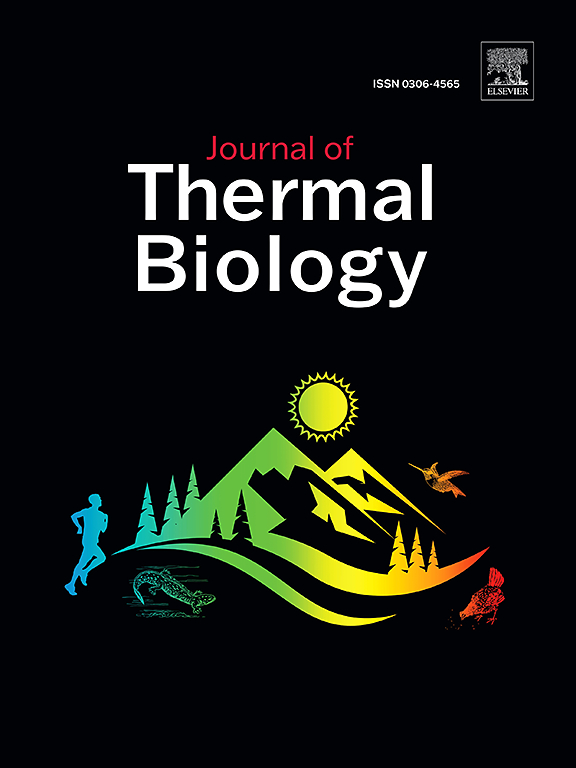Pomegranate peels ethanolic extract in free and nanoemulsified forms around mating and early pregnancy differently affect heat tolerance capacity and reproductive performance of ewes under heat stress
IF 2.9
2区 生物学
Q2 BIOLOGY
引用次数: 0
Abstract
Global warming is seriously threatening sheep farmings by increasing health problems and decreasing reproductive efficiency. In this study, pomegranate peels ethanolic extract (Ppee), rich in phenolic acids, was prepared in free (Fppee) and nanoemulsified (Nppee, with 18.49 nm–21.8 nm particles size) forms. The protective role of the extracts against heat stress impacts on homeothermy, metabolism and redox status, and reproductive performance of ewes was studied. A total of 36 Barki ewes were synchronized to estrus using two intramuscular injections PGF2α. On the day of the first PGF2α, ewes were allocated into three homogeneous experimental groups and received 300 mg/ewe/day Fppee, 300 mg/ewe/day Nppee, or not (control) until day 35 post-mating. The Fppee ewes showed the highest homeothermy in the morning, whereas the Nppee ewes showed the lowest homeothermy in the afternoon (P < 0.001). Both extracts increased plasma total protein, glucose, total antioxidant capacity, and glutathione concentrations (P < 0.001), whereas they decreased plasma urea, cholesterol, and malondialdehyde concentrations compared to control (P < 0.001). The highest and lowest values of these variables were for the Nppee ewes. The Nppee ewes had the significant lowest plasma progesterone concentrations. There were no differences in corpora lutea numbers and diameters. Lambs born to Fppee ewes had the highest birth weights and survivability. In conclusion, supplementing heat-stressed ewes with Fppee improved homeothermy, metabolism, redox status, and lamb weight and survivability without hampering reproductive performance, mainly by decreasing progesterone concentrations as observed in Nppee ewes.
在交配前后和妊娠早期,石榴皮乙醇提取物的游离和纳米乳化形式对热应激母羊的耐热能力和繁殖性能影响不同。
全球变暖增加了健康问题,降低了繁殖效率,严重威胁着绵羊养殖业。本研究制备了富含酚酸的石榴皮乙醇提取物(Ppee),分别为游离(Fppee)和纳米乳化(npee,粒径为18.49 nm ~ 21.8 nm)。研究了热应激提取物对母羊恒温、代谢和氧化还原状态以及繁殖性能的保护作用。36只Barki母羊通过两次肌肉注射PGF2α同步发情。在第一次PGF2α试验当天,将母羊分为3个均匀的试验组,分别给予300 mg/母羊/天Fppee、300 mg/母羊/天Nppee和不给予Fppee(对照组),直至交配后第35天。Fppee母羊在上午的同温性最高,而npee母羊在下午的同温性最低(P
本文章由计算机程序翻译,如有差异,请以英文原文为准。
求助全文
约1分钟内获得全文
求助全文
来源期刊

Journal of thermal biology
生物-动物学
CiteScore
5.30
自引率
7.40%
发文量
196
审稿时长
14.5 weeks
期刊介绍:
The Journal of Thermal Biology publishes articles that advance our knowledge on the ways and mechanisms through which temperature affects man and animals. This includes studies of their responses to these effects and on the ecological consequences. Directly relevant to this theme are:
• The mechanisms of thermal limitation, heat and cold injury, and the resistance of organisms to extremes of temperature
• The mechanisms involved in acclimation, acclimatization and evolutionary adaptation to temperature
• Mechanisms underlying the patterns of hibernation, torpor, dormancy, aestivation and diapause
• Effects of temperature on reproduction and development, growth, ageing and life-span
• Studies on modelling heat transfer between organisms and their environment
• The contributions of temperature to effects of climate change on animal species and man
• Studies of conservation biology and physiology related to temperature
• Behavioural and physiological regulation of body temperature including its pathophysiology and fever
• Medical applications of hypo- and hyperthermia
Article types:
• Original articles
• Review articles
 求助内容:
求助内容: 应助结果提醒方式:
应助结果提醒方式:


